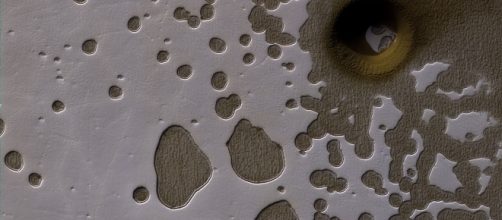Recently the Mars Reconnaissance Orbiter, which has been in orbit around the Red Planet since 2006, found a feature at the Martian South Pole that has scientists scratching their heads. The feature is a pit that looks like it is hundreds of meters wide and fairly deep. What caused the pit is something that scientists are not sure of yet.
What the Mars probe found
The region of Mars that the Mars Reconnaissance Orbiter was looking at is a portion of the south pole where the summer heat has started to vaporize some of the carbon dioxide ice that covers the region, exposing some of the ground underneath.
The land has a kind of Swiss cheese look to it. The pit in question is in the middle of this region. The MRO detects the clear reflection of ice at the bottom of the pit where it has apparently accumulated.
What caused the mysterious pit?
Mars has been bombarded with meteors for billions of years. Since most of its atmosphere has leached away since its warm, wet period, the meteors have pockmarked the surface of the Red Planet with numerous craters. Indeed, it is possible that this could have been caused by an ancient impact event.
On the other hand, the pit could have been caused by a seismic event, similar to how lava tubes have been created on Mars and on the moon. The idea is that the pit resulted from a sudden collapse after a buildup of lava.
Water erosion during Mars’ distant past is also being held out as a possibility,
The MRO HIRES camera
The image was taken by the MRI’s High-Resolution Imaging Science Experiment (HIRES) camera that is capable of taking a picture of an object at 50 centimeters per pixel. The camera is capable of taking pictures of features as little as a meter across from a height of 200 to 400 kilometers above the Martian surface.
The mission of the MRO
The MRO’s mission was initially supposed to last just two Earth years. The probe is designed to study Mars’ climate, atmosphere, and geology. It is also tasked with searching for water on the surface of Mars, the theory being that where water resides, life might also reside.
MRO has found and measured water ice at the north pole of Mars and also at the bottom of newly excavated craters. The probe also found deposits of chloride, thought to have formed when Mars’ seas and rivers evaporated over billions of years. Scientists believe that the chloride deposits may contain remnants of Martian life that may have thrived billions of years ago.


